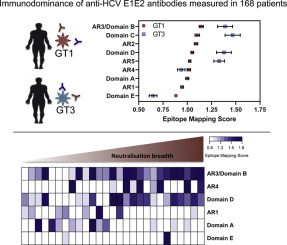当前位置:
X-MOL 学术
›
J. Hepatol.
›
论文详情
Our official English website, www.x-mol.net, welcomes your feedback! (Note: you will need to create a separate account there.)
B cell immunodominance in primary hepatitis C virus infection
Journal of Hepatology ( IF 25.7 ) Pub Date : 2020-04-01 , DOI: 10.1016/j.jhep.2019.11.011 Nicholas A Brasher 1 , Auda A Eltahla 1 , Alexander Underwood 1 , Irene Boo 2 , Simone Rizzetto 1 , Melanie R Walker 1 , Chaturaka Rodrigo 1 , Fabio Luciani 1 , Lisa Maher 1 , Heidi E Drummer 3 , Nicodemus Tedla 1 , Andrew R Lloyd 1 , Rowena A Bull 1
Journal of Hepatology ( IF 25.7 ) Pub Date : 2020-04-01 , DOI: 10.1016/j.jhep.2019.11.011 Nicholas A Brasher 1 , Auda A Eltahla 1 , Alexander Underwood 1 , Irene Boo 2 , Simone Rizzetto 1 , Melanie R Walker 1 , Chaturaka Rodrigo 1 , Fabio Luciani 1 , Lisa Maher 1 , Heidi E Drummer 3 , Nicodemus Tedla 1 , Andrew R Lloyd 1 , Rowena A Bull 1
Affiliation

|
BACKGROUND AND AIMS
Neutralising antibodies (NAb) play a key role in clearance of hepatitis C virus (HCV). NAbs have been isolated and mapped to several domains on the HCV Envelope proteins. However, the immunodominance of these epitopes in HCV infection remains unknown, hindering vaccine efforts to elicit optimal epitope-specific responses. Furthermore, it remains unclear which epitope-specific responses are associated with broad NAb (bNAb) activity in primary HCV infection. The aim of this study was to define B cell immunodominance in primary HCV, and its implications on neutralisation breadth and clearance. METHODS
Using samples from 168 subjects with primary HCV infection, the antibody responses targeted two immunodominant domains, termed domains B and C. Genotype 1 and 3 infections were associated with responses targeted towards different bNAb domains. RESULTS
No epitopes were uniquely targeted by clearers versus those who developed chronic infection. Samples with bNAb activity were enriched for multi-specific responses directed towards epitopes AR3, AR4 and domain D, and did not target non-neutralising domains. CONCLUSIONS
This study outlines for the first time a clear NAb immunodominance profile in primary HCV infection, and indicates that it is influenced by the infecting virus. It also highlights the need for a vaccination strategy to induce multi-specific responses that do not target non-neutralising domains.
中文翻译:

原发性丙型肝炎病毒感染中的 B 细胞免疫优势
背景和目的中和抗体 (NAb) 在清除丙型肝炎病毒 (HCV) 中起关键作用。NAb 已被分离并映射到 HCV 包膜蛋白上的几个域。然而,这些表位在 HCV 感染中的免疫优势仍然未知,阻碍了疫苗引起最佳表位特异性反应的努力。此外,尚不清楚哪些表位特异性反应与原发性 HCV 感染中的广泛 NAb (bNAb) 活性相关。本研究的目的是确定原发性 HCV 中的 B 细胞免疫优势,及其对中和广度和清除率的影响。方法使用来自 168 名原发性 HCV 感染受试者的样本,抗体反应针对两个免疫优势域,称为域 B 和 C。基因型 1 和 3 感染与针对不同 bNAb 结构域的反应相关。结果 与那些发生慢性感染的人相比,清除剂没有唯一靶向的表位。具有 bNAb 活性的样品针对针对表位 AR3、AR4 和域 D 的多特异性反应进行了富集,并且不针对非中和域。结论 本研究首次概述了原发性 HCV 感染中明确的 NAb 免疫优势谱,并表明它受感染病毒的影响。它还强调需要一种疫苗接种策略来诱导不针对非中和域的多特异性反应。具有 bNAb 活性的样品针对针对表位 AR3、AR4 和域 D 的多特异性反应进行了富集,并且不针对非中和域。结论 本研究首次概述了原发性 HCV 感染中明确的 NAb 免疫优势谱,并表明它受感染病毒的影响。它还强调需要一种疫苗接种策略来诱导不针对非中和域的多特异性反应。具有 bNAb 活性的样品针对针对表位 AR3、AR4 和域 D 的多特异性反应进行了富集,并且不针对非中和域。结论 本研究首次概述了原发性 HCV 感染中明确的 NAb 免疫优势谱,并表明它受感染病毒的影响。它还强调需要一种疫苗接种策略来诱导不针对非中和域的多特异性反应。
更新日期:2020-04-01
中文翻译:

原发性丙型肝炎病毒感染中的 B 细胞免疫优势
背景和目的中和抗体 (NAb) 在清除丙型肝炎病毒 (HCV) 中起关键作用。NAb 已被分离并映射到 HCV 包膜蛋白上的几个域。然而,这些表位在 HCV 感染中的免疫优势仍然未知,阻碍了疫苗引起最佳表位特异性反应的努力。此外,尚不清楚哪些表位特异性反应与原发性 HCV 感染中的广泛 NAb (bNAb) 活性相关。本研究的目的是确定原发性 HCV 中的 B 细胞免疫优势,及其对中和广度和清除率的影响。方法使用来自 168 名原发性 HCV 感染受试者的样本,抗体反应针对两个免疫优势域,称为域 B 和 C。基因型 1 和 3 感染与针对不同 bNAb 结构域的反应相关。结果 与那些发生慢性感染的人相比,清除剂没有唯一靶向的表位。具有 bNAb 活性的样品针对针对表位 AR3、AR4 和域 D 的多特异性反应进行了富集,并且不针对非中和域。结论 本研究首次概述了原发性 HCV 感染中明确的 NAb 免疫优势谱,并表明它受感染病毒的影响。它还强调需要一种疫苗接种策略来诱导不针对非中和域的多特异性反应。具有 bNAb 活性的样品针对针对表位 AR3、AR4 和域 D 的多特异性反应进行了富集,并且不针对非中和域。结论 本研究首次概述了原发性 HCV 感染中明确的 NAb 免疫优势谱,并表明它受感染病毒的影响。它还强调需要一种疫苗接种策略来诱导不针对非中和域的多特异性反应。具有 bNAb 活性的样品针对针对表位 AR3、AR4 和域 D 的多特异性反应进行了富集,并且不针对非中和域。结论 本研究首次概述了原发性 HCV 感染中明确的 NAb 免疫优势谱,并表明它受感染病毒的影响。它还强调需要一种疫苗接种策略来诱导不针对非中和域的多特异性反应。



























 京公网安备 11010802027423号
京公网安备 11010802027423号